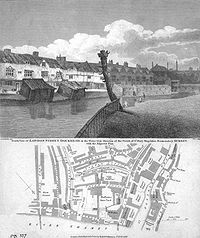Jacob's Island

Jacob's Island was a notorious rookery in Bermondsey, Surrey, on the south bank of the River Thames. It was separated the street named Shad Thames to the west by St Saviour's Dock, the point where the subterranean River Neckinger enters the Thames, and on the other two sides by tidal ditches, one just west of George Row and the other just north of London Street (now named Wolseley Street).
Description
Jacob's Island was immortalised by Charles Dickens's novel Oliver Twist, in which the principal villain Bill Sikes meets a nasty end in the mud of 'Folly Ditch'. Dickens provides a vivid description of what it was like:
| “ | ... crazy wooden galleries common to the backs of half a dozen houses, with holes from which to look upon the slime beneath; windows, broken and patched, with poles thrust out, on which to dry the linen that is never there; rooms so small, so filthy, so confined, that the air would seem to be too tainted even for the dirt and squalor which they shelter; wooden chambers thrusting themselves out above the mud and threatening to fall into it - as some have done; dirt-besmeared walls and decaying foundations, every repulsive lineament of poverty, every loathsome indication of filth, rot, and garbage: all these ornament the banks of Jacob's Island. | ” |
Dickens was taken to this then-impoverished and unsavory location by the officers of the river police, with whom he would occasionally go on patrol. When a local politician attempted to deny the very existence of Jacob's Island, Dickens gave him short shrift, describing the area as "the filthiest, the strangest, the most extraordinary of the many localities that are hidden in London".
The area was once notoriously squalid and described as "The very capital of cholera" and "The Venice of drains" by the Morning Chronicle of 1849. The ditches were filled in the early 1850s, and the area later redeveloped as warehouses.

Henry Mayhew described Jacob's Island thus:
On entering the precincts of the pest island the air had literally the smell of a graveyard, and a feeling of nausea and heaviness came over any one unaccustomed to imbibe the moist atmosphere. Not only the nose, but the stomach told how heavily the air was loaded with sulphuretted hydrogen; and as soon as you crossed one of the crazy and rotten bridges over the reeking ditch, you knew, as surely as if you had chemically tested it, by the black colour of what was once white lead paint upon the door posts and window sills, that the air was thickly charged with this deadly gas. The heavy bubbles which now and then rose up in the water showed you whence at least a portion of the mephitic compound issued, while the open doorless privies that hung over the water-side, and the dark streaks of filth down the walls, where the drains from each house discharged themselves in to the ditch were proofs indisputable as to how the pollution of the ditch occurred.The water was covered with scum almost like a cobweb, and prismatic with grease. In it floated large masses of rotting weed, and against the posts of the bridges were swollen carcases of dead animals, ready to burst with the gases of putrefaction. Along its shores were heaps of indescribable filth, the phosphoretted smell from which told you of the rotting fish there, while the oyster-shells were like pieces of slate from their coating of filth and mud. In some parts the fluid was as red as blood from the colouring matter that poured into it from the reeking leather dressers’ close by." [1]
Development
Jacob's Island was extensively bombed during the Second World War and today only one Victorian warehouse survives. Over the past twenty years the Island area has undergone considerable regeneration and gentrification, including a development by architects Lifschutz Davidson Sandilands.
Outside links
- Image and map of Jacob's Island, Bermondsey, 1813
- Image of Jacob's Island, Bermondsey, c. 1880
- Dickens' London map
References
- ↑ in a letter to the Chronicle of 24 September 1849; from “Selections from London Labour and the London Poor”, Oxford University Press, 1965, page xxxvi